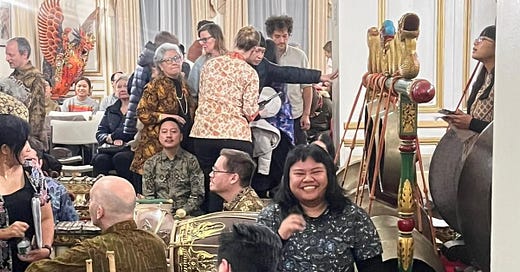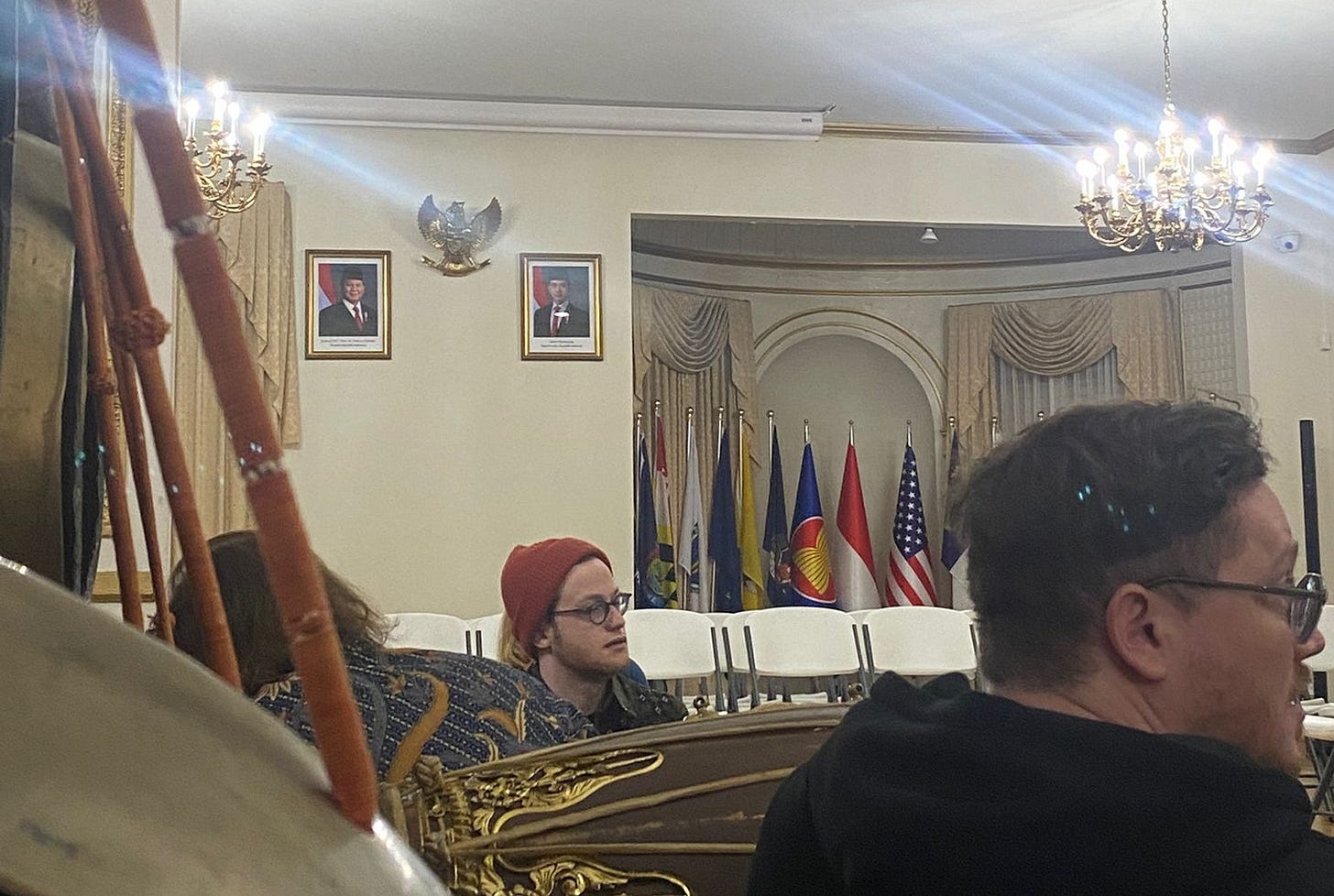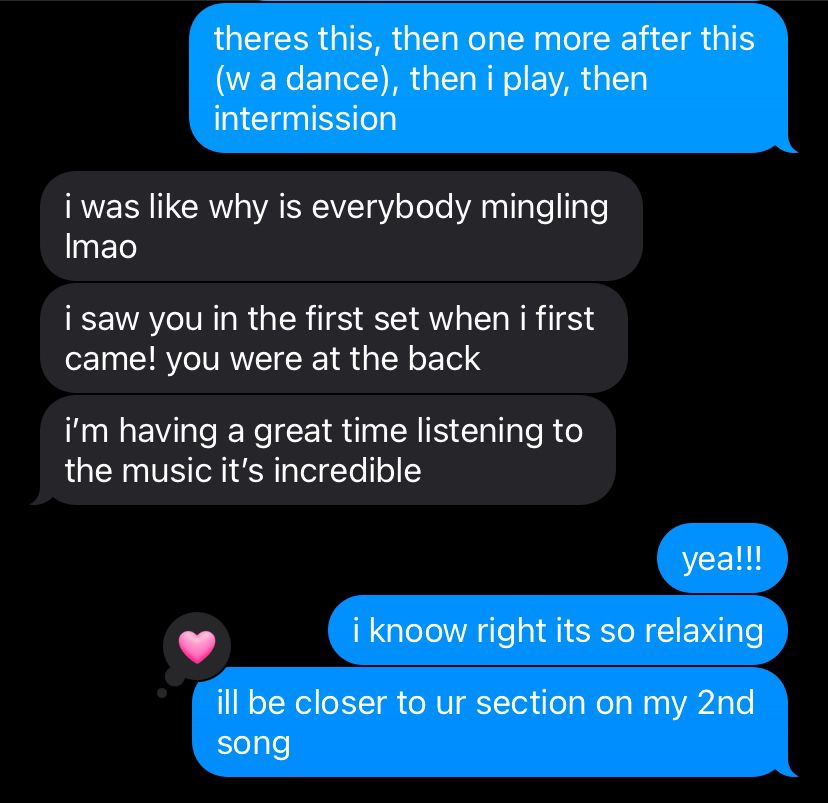hey all! writing this the morning after my first ever javanese gamelan performance. learned a lot from a single performance and just talking to people around it.
i started out arriving to the indonesian consulate to set up and practice. what i noticed when i rehearsed the piece i played kethuk in, i’m directly facing the newly minted portraits of our new president and vice president, prabowo subianto and gibran rakabuming, on the far end of the room, as if taunting me.
i haven’t been in touch with indonesian twitter to have the realization fully set in that we’ve reached this cycle of the reformation that furls back to the new order, but it’s been creeping on me for a while. i was just looking into wiji thukul’s life for a questionnaire answer on poets who inspire me to write, and the truth sank in to me that prabowo is part of the military order who disappeared wiji thukul. a lot of his poetry has been on my mind, especially bunga dan tembok (“flowers and walls”), about the power of the masses against tyranny. thinking about the fascist & neoliberal presidents who have been in power, and thinking about how all of them are javanese.
my friend juan, who was born and raised in manado, was helping out with the livestream, and he commented about the lack of diaspora practice in eastern indonesian cultures. “why is it always that the javanese and balinese cultural products the ones that are exhibited at the consulate?” we asked. staring at the prabowo and gibran portrait, it makes me think… as a javanese person, what does it mean to be practicing javanese art when our ethnicity has been the biggest domestic oppressing force in indonesia? does it happen to be this way? can we divorce javanese culture from the javanese oligarchs?
this makes me think about a few things. since juan and i are volunteering for livestream duties, we sat in the back and got to know someone from the kraton jogja/the royal palace of jogjakarta (hiiii mas talcha if you’re reading this), whose wife and him work as abdi dalem and whose wife mbak dewa is fulfilling an appointment to be a visiting assistant professor of dance at wesleyan, and had a few insightful conversations. we mentioned the stark elephant in the room - that most of the people studying gamelan in the US are white americans - and commented how this often has been a push from the state or educating forces to guilt trip indonesians into learning their culture. sure, there is a big problem of younger generations of indonesia not learning javanese gamelan because of the cultural stigma attached to it - because it’s mysterious and spooky - but at the same time, when white people come to indonesia to learn or play gamelan, they become topics of headlines and op-eds of older javanese oligarchs, who guilt trip by saying “if white people are interested in playing it why aren’t you?” when the issue is more complicated than an individual’s willingness, such as lack of access and different modes of learning, the defunding of indonesian academia, and the weight of javanese supremacy itself.
there could be a possibility of divorcing javanese art from javanese supremacy. for example, in a tumpeng dish, there is this institutionalized way of cutting the rice that emulates the western tradition of cutting birthday cakes - you cut the top and give it to the most important person, especially in events - when in tradition, the top of the tumpeng resembles god and you’re supposed to carve the rice and eat them with the accoutrements until the top finally is brought down to the rest of the rice - a symbol of god returning blessings to the people. i’ve always liked the javanese value of gotong royong, of how our society focuses on the masses instead of individual needs. the tumpeng brings blessings to the masses. the javanese gamelan ensemble listens to each other and plays together. wiji thukul writing about the flowers engulfing the walls. maybe the key is to reject neoliberal imperialism, that prioritizes the individual few, and back to gotong royong, prioritizing the masses.
ANYWAY! the show started and it was really fun. i played two pieces with the wednesday beginners group: the first one is the opening piece “wilujeng” and the second one with a dance group “ayun-ayun”. i played the peking in “wilujeng”, which is a more complex elaborating instrument. honestly i was so nervous about getting the notes right and the tempo right - the rehearsal before the show was the first time we played with a full ensemble and i was making a lot of mistakes because i had to learn to listen again with the new arrangement. but when the show started, i felt no difficulty at all and hit all the notes right. my hands felt light on top of the instrument and i didn’t have to look at the notation that much - almost feels like someone else was controlling it. the music felt so peaceful and natural to my ears. it was a complete opposite shift from the rehearsal earlier, and it feels like something more than just logic. of course, there’s logical ways to understand it: i’ve rehearsed this piece for half a year, there’s muscle memory, etc… but i want to believe that my ancestors are speaking to me. i’m not usually one to believe in woo woo shit but honestly i felt like it! i feel at home with the music and maybe that’s because i feel a lot of joy in learning about myself and where my lineage comes from, even though i’m a jakarta brat who can’t even speak javanese. and maybe that moment my ancestors are controlling my hands and the way i play… who knows!
i played the kethuk on the ayun-ayun, which felt much easier, and i get to absorb the music around me more. everything sounded so good, which even my non-indonesian friends agreed with.
we had a break in the middle and i explained how the instruments work to my friends. (if you’re curious, check out my previous post and my first post on gamelan!) i played during the first set from 4pm to 6pm, but i stayed for the second set from 7pm to 10pm because i had livestream duties.
i continued to talk to mas talcha, especially things i’ve been curious about the kraton jogja. i told him about the recently broken news about six indonesian artifacts returned to indonesia from the district attorney of new york, and he told me that the kraton has been leading similar efforts. the process starts by establishing partnerships with museums around the world, mostly the netherlands, and starting negotiations to return these artifacts to indonesia. the biggest challenge facing them are 1. sometimes the museums in the west will only want to return digital copies of the artefacts, especially manuscripts, 2. it cost a lot of money & resources for the upkeep of these objects, so the kraton or the national museum of indonesia needs to be fully equipped. he also mentions that the kraton just established their art restoration wing, so this is exciting news for them.
this makes me curious about the archival practices of the kraton, so i asked him about it. the kraton categorizes cultural objects in two categories: pusaka (heirloom/heritage) objects or regular objects. pusaka objects are considered sacred, so they are handled with special care and are not exhibited to the public, and the regular objects are often exhibited to the public through curated exhibitions, such as the current parama iswari exhibition celebrating the women of the kraton. however, these objects are not just collecting dust in storage. he mentions most pusaka objects related to the performance arts are used in sacred holidays, such as the gamelan sekaten, while pusaka objects like cups and teapots are paid attention to very often, some every day! performance arts objects are not just collecting dust, but they are being celebrated as part of javanese life. this makes me think more about the implicit violence of western archival practices - that our culture in the west is one to be observed to death, instead of celebrated to life.
fun fact i learned too is in jogja, the kraton gamelan sets are the lowest pitch out of all the gamelan sets in jogja - gamelan makers are respectful to not make their gamelan a lower pitch than the kraton sets. jon, the mentor of the beginner group, mentioned that to tune a gamelan, you scrape the metal under it, and usually the oldest/most sacred ones are the lowest pitches.
the second set is also when the real woo woo shit happened. there is this painting near the door (but opposing it) of borobudur temple that keeps shaking when the gamelan is playing. it keeps shaking even when the door is closed, sometimes to the rhythm of the gamelan. the consulate building is notoriously haunted, at least through the experiences of my friends who worked there, and that are some parts of the building that really creeped me out. i’ve heard a lot of stories like a story about a lady who killed herself in the building, or that sukarno’s ghost hangs out once in a while (greatest city in the world even in the afterlife, baby!), but for some reason the shaking - or dancing - painting feels fascinating to me. i can’t stop watching it. there’s a joy in it’s energy. (AGAIN with the woo woo shit!) i told juan about it and he got creeped out, i told ryan and with total white guy energy he approached the painting to investigate it (i told him “you’d be the first person to die in a horror film”), i told mas talcha and he simply said “it’s happy to hear some gamelan.” honestly i agree with him the most, and i expect that answer from someone who works in the kraton and is in close proximity with these pusaka objects.
a similar experience happened to me, during the pandemic, where my friends and i were hanging out in a place i was subletting. my friend argie lost her trusted portable fan (it was the heat of summer), and we flipped the whole apartment trying to look for it. the most obvious place to search is under the bed, and there was definitely no fan - it was empty under there. a few minutes later argie and i looked under the bed again and we found it, clear as day. we got creeped out but we said to each other nonchalantly “oh the caretaker of this place is messing with us. silly you!” when our other friends, who are non-american, asked what happened, we tried to explain it in the least creepy way, but nevertheless it freaked them out. indonesians are soooo nonchalant when it comes to spirits: we just acknowledge that it’s there and it’s just some guy, but we herald them with a high degree of respect. we respect the gamelan by not stepping over the metal, but we congregate and live with them. this is a similar sentiment to southeast asians, and most notably is a recurring theme in apichatpong weerasethakul’s filmography, where he features a lot of characters nonchalantly reacting to dead people or really creepy entities.
honestly looking at the moving painting didn’t creep me out at all. it made me feel in peace. like my ancestors are congregating with me.
there’s so much to look forward to in the next year. now that it’s not peak rehearsal-for-performance season anymore, i look forward to learning more elaborating instruments. i want to keep learning the peking, the bonang maybe? the gender and the gambang? we’ll see! mbak nana (hiiii if you’re reading this) also said we are starting to work on pieces with male dancers, so it’s great to see some variety soon.
most of all this has been such a rewarding journey. maybe i should quit my job and become an abdi dalem?







